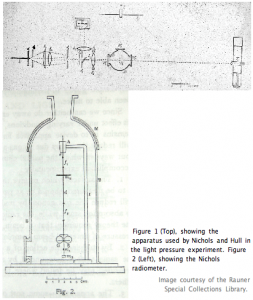Nichols radiometer

A Nichols radiometer was the apparatus used by Ernest Fox Nichols and Gordon Ferrie Hull in 1901 for the measurement of radiation pressure.
It consisted of a pair of small silvered glass
kPa). The radiant energy of the incident beam was deduced from its heating effect upon a small blackened silver disk, which was found to be more reliable than the bolometer
when it was first used. With this apparatus, the experimenters were able to obtain an agreement between observed and computed radiation pressures within about 0.6%.
The original apparatus is at the Smithsonian Institution.[1]
This apparatus is sometimes confused with the Crookes radiometer of 1873.
The original papers, with their historical context, have been re-printed in a chapter of the book Quantum Photonics: Pioneering Advances and Emerging Applications.[2]
See also
References
- ^ Lee, Dillon (2008). "A Celebration of the Legacy of Physics at Dartmouth". Dartmouth Undergraduate Journal of Science. Dartmouth College. Retrieved 2009-06-11.
- S2CID 171448261, retrieved 2023-08-22
- Lebedew, Peter (1901). "Untersuchungen über die Druckkräfte des Lichtes" [Experimental examination of light pressure] (PDF). Annalen der Physik (in German). 311 (11). Wiley: 433–458. (PDF) from the original on 2022-10-10. Retrieved July 28, 2019.
- Nichols, E. F.; Hull, G. F. (1901). "A Preliminary Communication on the Pressure of Heat and Light Radiation". Physical Review. Series I. 13 (5). American Physical Society (APS): 307–320. (PDF) from the original on 2019-05-04.
- E.F. Nichols and G.F. Hull, The Pressure due to Radiation, The Astrophysical Journal, Vol.17 No.5, p. 315-351 (1903)
- Nichols, E. F.; Hull, G. F. (1903-07-01). "The Pressure Due to Radiation. (Second Paper.)". Physical Review. Series I. 17 (1): 26–50. .
- Bell, Mary; Green, S E (1933-03-01). "On radiometer action and the pressure of radiation". Proceedings of the Physical Society. 45 (2): 320–357. ISSN 0959-5309.
- Measuring the Pressure of Light: Pure Science at Dartmouth – Dartmouth Undergraduate Journal of Science
